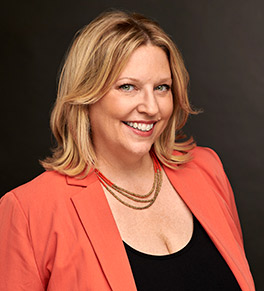Eliminating GERD for good

Gastroesophageal reflux disease (GERD) — one of the most prevalent digestive disorders in the United States — sends more than 18 million people in search of medical help each year.
Chronic heartburn and painful regurgitation of stomach acids are the primary symptoms and they can dramatically affect a person’s quality of life. Over time, GERD can damage the esophageal lining, resulting in precancerous Barrett’s esophagus and esophageal cancer.
Tori Clive Herendeen has suffered from gastroesophageal reflux for most of her life.
“I can remember when I was five, my mom gave me some ketchup,” the Rancho Palos Verdes woman recalls. “I told her it gave me heartburn. She said, ‘You’re five years old. You shouldn’t have heartburn,’ but I really did.”
Fortunately, Herendeen found UCI Health gastroenterologist and GERD expert Dr. Kenneth Chang, who was able to offer relief with a groundbreaking procedure he and gastrointestinal surgeon Dr. Ninh T. Nguyen pioneered called concomitant transoral incisionless fundoplication (cTIF).
Performed in a single session by an interventional gastroenterologist and a surgeon, cTIF provides a permanent solution for GERD patients, says Chang, executive director of the UCI Health Chao Digestive Health Institute and a leading U.S. interventional gastroenterologist.
Lifelong GERD symptoms
Herendeen had all the typical symptoms of GERD.
“I had bloating in my stomach and the acid taste in my mouth from the stomach acid flowing back into my throat,” she says. “My throat was always sore and my voice sounded scratchy.”
By her 20s, Herendeen was desperate for help. Her first endoscopy showed a hiatal hernia — where the stomach pushes through a small opening (hiatus) in the diaphragm. Her doctor said it could be causing her symptoms and prescribed a medication known as a proton pump inhibitor (PPI) to reduce the acids produced in her stomach.
The medication presented other challenges. “When I started taking them, I started to gain weight. I was having much more bloating in my stomach area and had an overall feeling of unhealthiness,” she says.
By the time Herendeen turned 40, the medications had stopped working altogether and she actively began searching for a better solution.
She had heard about the cTIF procedure and consulted a gastroenterologist and a surgeon in the South Bay, who both told her they thought cTIF was too “radical.”
“I was in constant agony,” says Herendeen, who decided she wanted a second opinion.
“A friend of mine worked at a different Orange County hospital that was trying to launch the cTIF procedure and she knew that Dr. Chang was already performing it at UCI Health.”
She immediately made an appointment with him to learn more.
What is cTIF?
The procedure combines laparoscopic hiatal hernia repair with transoral incisionless fundoplication, or TIF®, to correct the root cause of GERD, which is an anatomic defect involving the gastroesophageal valve.
“We are able to rebuild the lower esophageal valve so that it closes properly, restoring the body's natural protection against chronic reflux,” says Chang, a professor and chief of gastroenterology at the UCI School of Medicine who holds the Vincent Kong Endowed Chair in Gastrointestinal Endoscopic Oncology.
“The TIF™ procedure alone is revolutionary because it really fills a large treatment gap by offering a less invasive endoscopic procedure that gets to the root of gastroesophageal reflux,” Chang says.
Randomized control studies demonstrate that after the TIF procedure, more than 80% of patients have great control of their reflux symptoms and can eliminate the use of acid-reducing medications, he adds.
“The fact that we can now combine the hernia repair with the TIF procedure opens up a wider spectrum of patients who could benefit,” says Nguyen, associate director of the Digestive Health Institute, the UCI School of Medicine John E. Connolly Professor of Surgery and chair of the Department of Surgery.
From pain to pursuing life to the fullest
“I had my first consultation with Dr. Chang in the spring of 2019,” Herendeen says. “He was excited because he thought I would be a great candidate for the cTIF procedure.”
She, too, was elated because it would be a minimally invasive procedure with an easy recovery and no side effects.
Chang and Nguyen performed Herendeen’s cTIF just before Thanksgiving 2019.
“Dr. Nguyen marveled at how calm I was. I told him it was because both he and Dr. Chang were so thorough and patient with all my questions. I knew I was in excellent hands.”
More than three years later, Herendeen remains symptom free with no need for acid-reducing medications, her risk of developing Barrett's esophagus or esophageal cancer dramatically reduced.
“When I have my follow-ups with Dr. Chang, I always tell him how life-changing this procedure was for me,” she says. “CTIF was everything they promised and more.”
She enthusiastically spreads the word about the treatment to anyone who will listen.
“Every single person I met on this journey was competent, caring and wonderful to work with at UCI Health and I would one thousand percent do the procedure again.”
Free of the symptoms and pain of GERD, Herendeen now practices yoga and Pilates. She’s also able to eat spicy foods and enjoy simple pleasures others take for granted.
“Margaritas and wine are now on the agenda,” she says with a laugh. “It feels great to be back doing the things I love again!”
Related stories
Explore further
Browse more blog posts by topic.




